The Influence of Dopant Concentration on Optical-Electrical Features of Quantum Dot-Sensitized Solar Cell
Abstract
:1. Introduction
2. Results and Discussion
2.1. Structural Characterization
2.2. Optical Characterization
2.3. Electrical Properties
3. Experiment
3.1. Materials
3.2. Preparation Processes
Fabrication of Cu2+ Doped, Mn2+ Doped, and Ag+ Doped CdSe Films
4. Conclusions
Author Contributions
Funding
Institutional Review Board Statement
Informed Consent Statement
Data Availability Statement
Conflicts of Interest
References
- Chattopadhyay, S.; Sen, P.; Andrews, J.T.; Sen, P.K. Semiconductor core-shell quantum dot: A low temperature nano-sensor material. J. Appl. Phys. 2012, 111, 034310. [Google Scholar] [CrossRef]
- Ariful, A.; He, T.; Eid, K.; Abdullah, A.M.; Curry, M.L.; Du, A.; Puente Santiago, A.R.; Echegoyen, L.; Noveron, J.C. Tuning the Intermolecular Electron Transfer of Low-Dimensional and Metal-Free BCN/C60 Electrocatalysts via Interfacial Defects for Efficient Hydrogen and Oxygen Electrochemistry. J. Am. Chem. Soc. 2021, 143, 1203–1215. [Google Scholar]
- Sanchez-Ramirez, E.A.; Hernandez-Perez, M.A.; Aguilar-Hernandez, J.; Rangel-Salinas, E. Nanocrystalline CdS1−xSex alloys as thin films prepared by chemical bath deposition: Effect of x on the structural and optical properties. J. Alloys Compd. 2014, 615, 511–514. [Google Scholar] [CrossRef]
- Husain, M.; Pal Singh, B.; Kumar, S.; Sharma, T.P.; Sebastian, P.J. Optical, electrical and structural investigations on Cd1−xZnxSe sintered films for photovoltaic applications. Sol. Energy Mater. Sol. Cells 2003, 76, 399–415. [Google Scholar] [CrossRef]
- Sanchez-Ramirez, E.A.; Hernandez-Perez, M.A.; Aguilar-Hernandez, J.R. Study on the introduction of Se into CdS thin films: Influence on the kinetics of the deposition and the structural and optical properties. Appl. Surf. Sci. 2015, 347, 35–39. [Google Scholar] [CrossRef]
- Shockley, W.; Queisser, H.J. Detailed balance limit of efficiency of p-n junction solar cells. J. Appl. Phys. 1961, 32, 510–519. [Google Scholar] [CrossRef]
- Hagfeldt, A.; Boschloo, G.; Sun, L.; Kloo, L.; Pettersson, H. Dye-sensitized solar cells. Chem. Rev. 2010, 110, 6595–6663. [Google Scholar] [CrossRef] [PubMed]
- Phuc, D.H.; Tung, H.T. Band tunable CdSe quantum dot-doped metals for quantum dot-sensitized solar cell application. Int. J. Photoenergy 2019, 2019, 9812719. [Google Scholar] [CrossRef]
- Wang, P.; Abrusci, A.; Wong, H.M.P.; Svensson, M.; Anderson, M.R.; Greenham, N.C. Photoinduced charge transfer and efficient solar energy conversion in a blend of a red polyfluorene copolymer with CdSe nanoparticles. Nano Lett. 2006, 6, 1789–1793. [Google Scholar] [CrossRef]
- Fan, S.-Q.; Fang, B.; Kim, J.H.; Jeong, B.; Kim, C.; Yu, J.-S.; Ko, J. Ordered multimodal porous carbon as highly efficient counter electrodes in dye-sensitized and quantum-dot solar cells. Langmuir 2010, 26, 13644–13649. [Google Scholar] [CrossRef] [PubMed]
- Fan, S.-Q.; Cao, R.-J.; Xi, Y.-X.; Gao, M.; Wang, M.-D.; Kim, D.-H.; Kim, C.-W.; Ko, J.-J. CdSe quantum dots as co-sensitizers of organic dyes in solar cells for red-shifted light harvesting. Optoelectron. Adv. Mater. Rapid Commun. 2009, 3, 1027–1033. [Google Scholar]
- Song, L.; Duan, J.; Zhan, J. One-pot Microwave Assisted Synthesis of Homogeneously Alloyed CdSexTe1−x Nanocrystals with Tunable Photoluminescence. Mater. Lett. 2010, 64, 1843–1845. [Google Scholar] [CrossRef]
- Vogel, R.; Pohl, K.; Weller, H. Sensitization of highly porous, polycrystalline TiO2 electrodes by quantum sized CdS. Chem. Phys. Lett. 1990, 174, 241–246. [Google Scholar] [CrossRef]
- Tung, H.T.; Phuc, D.H.; Chung, N.T.K.; Thuy, N.T.N. Enhanced light absorption and charge recombination control in quantum dot sensitized solar cells using Copper and Manganese doped cadmium sulfide quantum dots. Environ. Prog. Sustain. Energy 2021, e13650. [Google Scholar] [CrossRef]
- Ramasamy, K.; Malik, M.A.; Helliwell, M.; Raftery, J.; O’Brien, P. Thio-and dithio-biuret precursors for zinc sulfide, cadmium sulfide, and zinc cadmium sulfide thin films. Chem. Mater. 2011, 23, 1471–1481. [Google Scholar] [CrossRef]
- Tauc, J.; Radu, G.; Anina, V. Optical properties and electronic structure of amorphous germanium. Phys. Status Solidi 1966, 15, 627–637. [Google Scholar] [CrossRef]
- Ha, T.T.; Chi, C.H.; Vy, N.T.; Thoa, N.T.P.; Huynh, T.D.; Lam, Q.V. Improving the performance of QDSSCs based on TiO2/CdS(Silar)/CdSe(Colloid)/Zns(Silar) photoanodes. Environ. Prog. Sustain. Energy 2015, 34, 1774–1779. [Google Scholar] [CrossRef]
- Ueda, Y.; Ohtani, T. Mechanochemical Synthesis, Vacancy-Ordered Structures and Low-Dimensional Properties of Transition Metal Chalcogenides. Handb. Solid State Chem. 2017, 383–433. [Google Scholar] [CrossRef]
- Al-Bataineh, Q.M.; Alsaad, A.M.; Ahmad, A.A.; Al-Sawalmih, A. Structural, electronic and optical characterization of ZnO thin film-seeded platforms for ZnO nanostructures: Sol–gel method versus ab initio calculations. J. Electron. Mater. 2019, 48, 5028–5038. [Google Scholar] [CrossRef]
- Siddiqui, F.Y.; Shaikh, S.U.; Desale, D.J.; Upadhye, D.S.; Mahajan, S.V.; Ghule, A.V.; Varshney, P.; Han, S.-H.; Sharma, R. Band gap engineering by substitution of S by Se in nanostructured CdS1− xSex thin films grown by soft chemical route for photosensor application. Mater. Sci. Semicond. Process. 2014, 27, 404–411. [Google Scholar] [CrossRef]
- Mondal, R.; Miyaki, N.; Becerril, H.A.; Norton, J.E.; Parmer, J.; Mayer, A.C.; Tang, M.L.; Brédas, J.-L.; McGehee, M.D.; Bao, Z. Synthesis of acenaphthyl and phenanthrene based fused-aromatic thienopyrazine co-polymers for photovoltaic and thin film transistor applications. Chem. Mater. 2009, 21, 3618–3628. [Google Scholar] [CrossRef]
- Urbach, F. The long-wavelength edge of photographic sensitivity and of the electronic absorption of solids. Phys. Rev. 1953, 92, 1324. [Google Scholar] [CrossRef]
- Venables, J. Introduction to Surface and Thin Film Processes; Cambridge University Press: Cambridge, UK, 2000. [Google Scholar]
- Pattanaik, A.K.; Srinivasan, A. Electrical and optical studies on Pb-modified amorphous Ge–Se–Te films. Semicond. Sci. Technol. 2003, 19, 157. [Google Scholar] [CrossRef]
- Neamen, D.A. Semiconductor Physics and Devices: Basic Principles; McGraw-Hill: New York, NY, USA, 2012. [Google Scholar]
- Muthalif, M.P.A.; Lee, Y.-S. Chozhidakath Damodharan Sunesh, Hee-Je Kim, and Youngson Choe. Enhanced photovoltaic performance of quantum dot-sensitized solar cells with a progressive reduction of recombination using Cu-doped CdS quantum dots. Appl. Surf. Sci. 2017, 396, 582–589. [Google Scholar] [CrossRef]
- Guijarro, N.; Lana-Villarreal, T.; Mora-Seró, I.; Bisquert, J.; Gómez, R. CdSe quantum dot-sensitized TiO2 electrodes: Effect of quantum dot coverage and mode of attachment. J. Phys. Chem. C 2009, 113, 4208–4214. [Google Scholar] [CrossRef]
- Shen, Q.; Kobayashi, J.; Diguna, L.J.; Toyoda, T. Effect of ZnS coating on the photovoltaic properties of CdSe quantum dot-sensitized solar cells. J. Appl. Phys. 2008, 103, 084304. [Google Scholar] [CrossRef]
- Rühle, S.; Shalom, M.; Zaban, A. Quantum-dot-sensitized solar cells. ChemPhysChem 2010, 11, 2290–2304. [Google Scholar] [CrossRef]




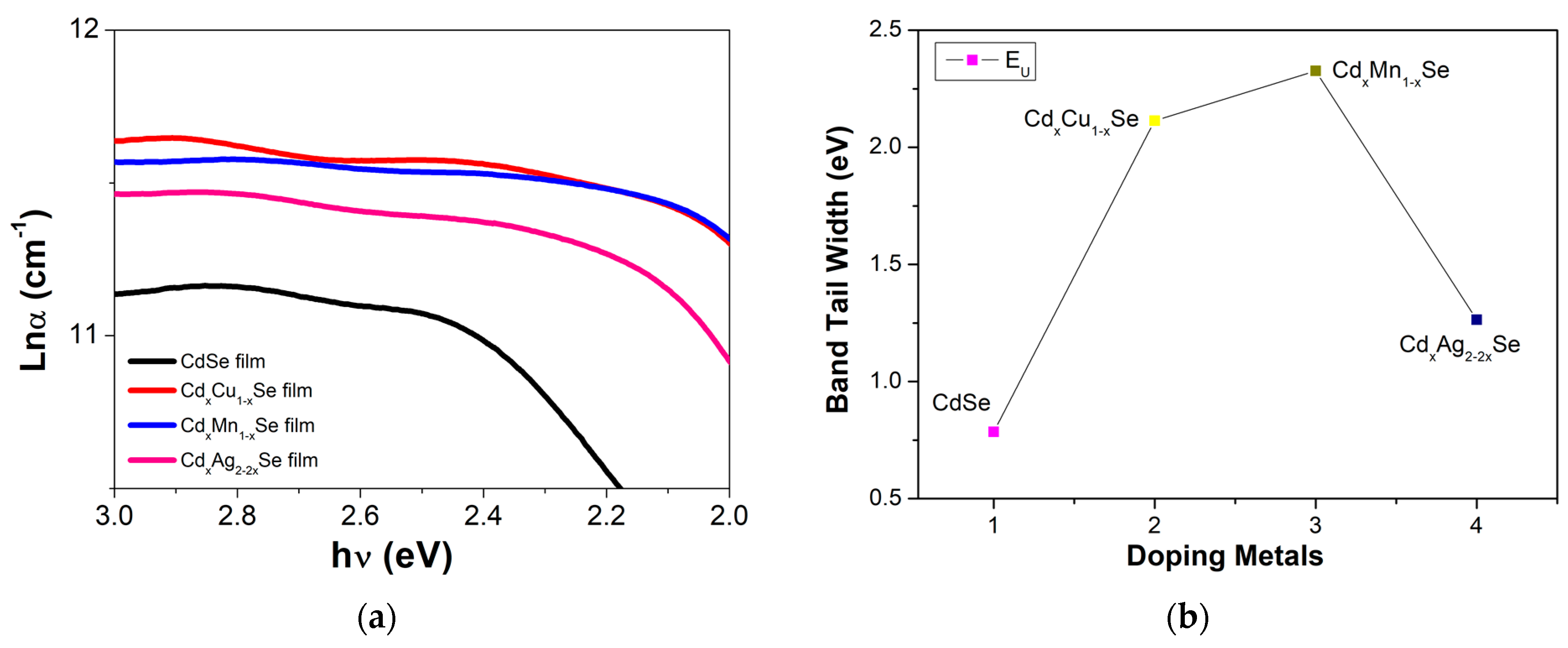

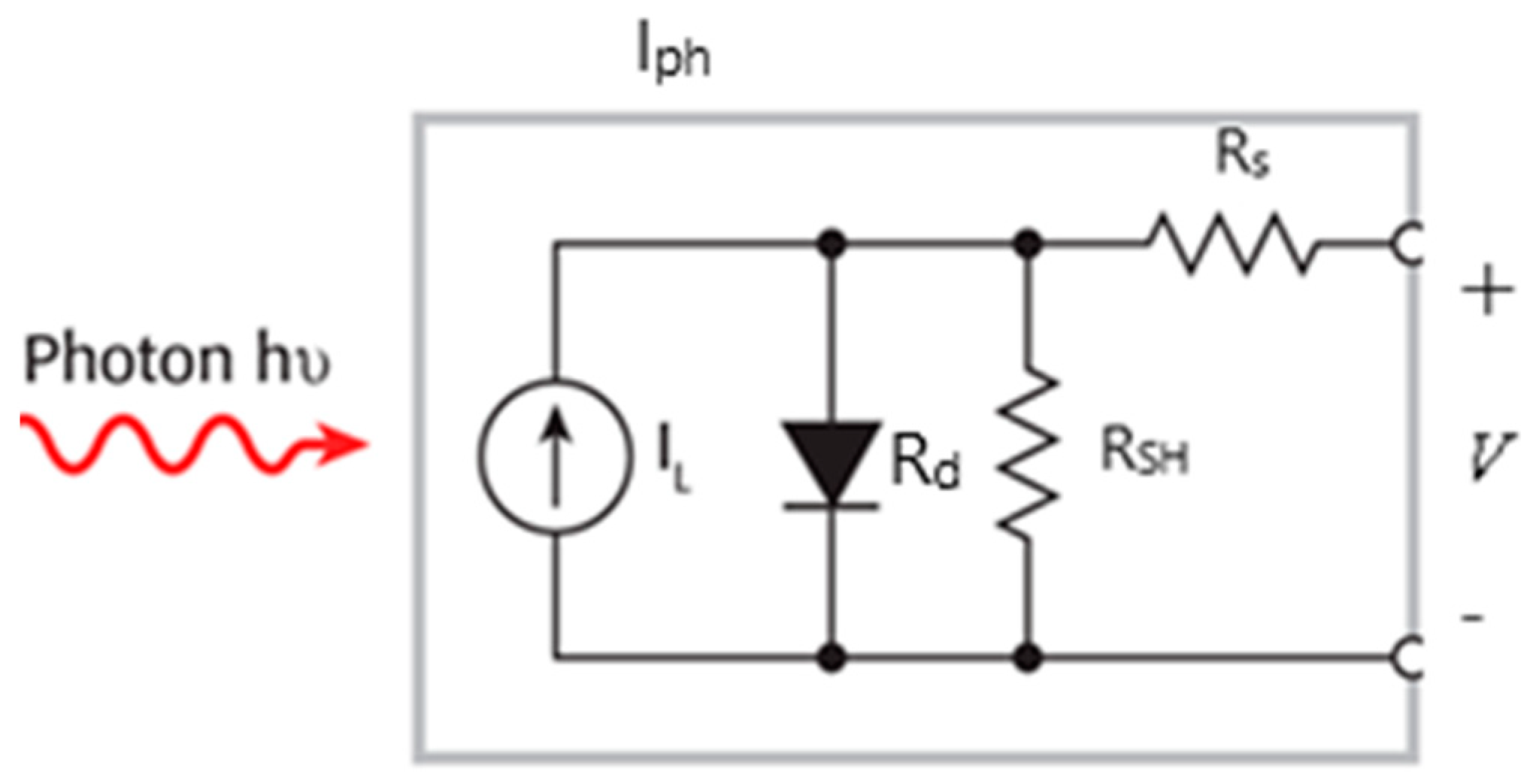
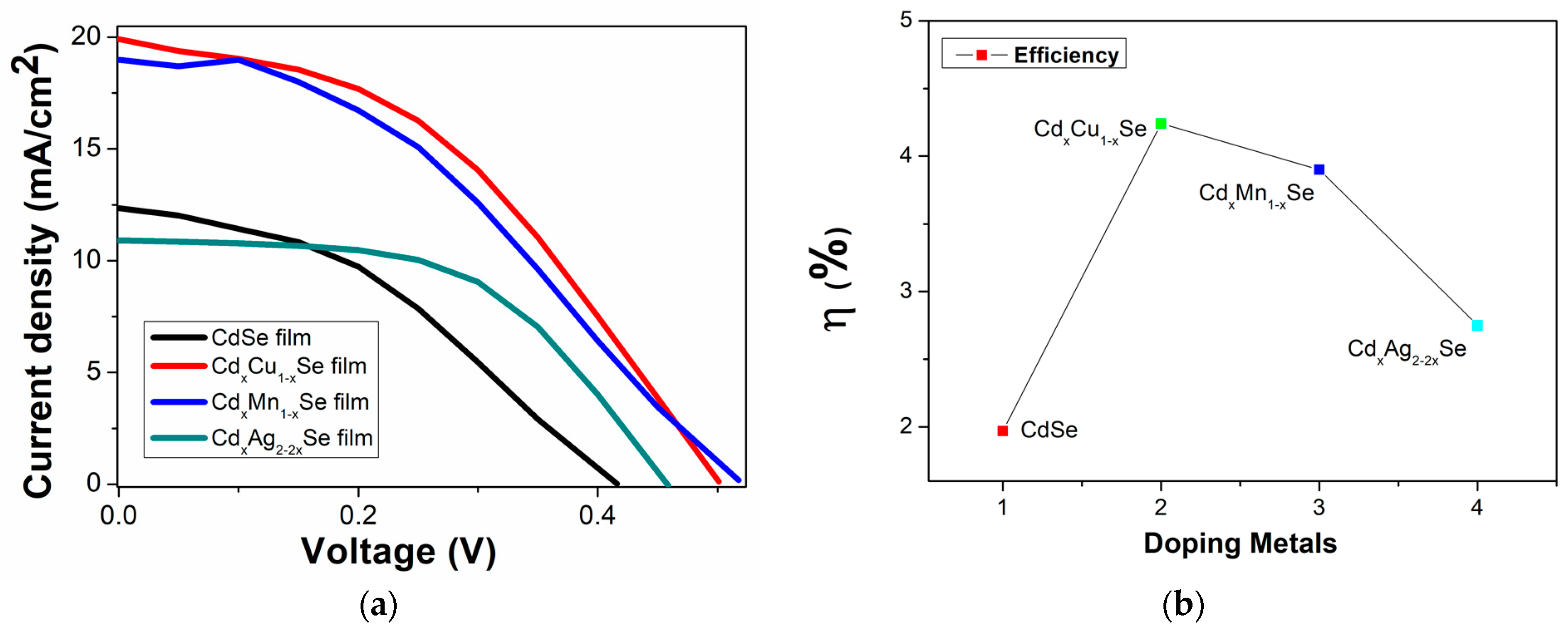
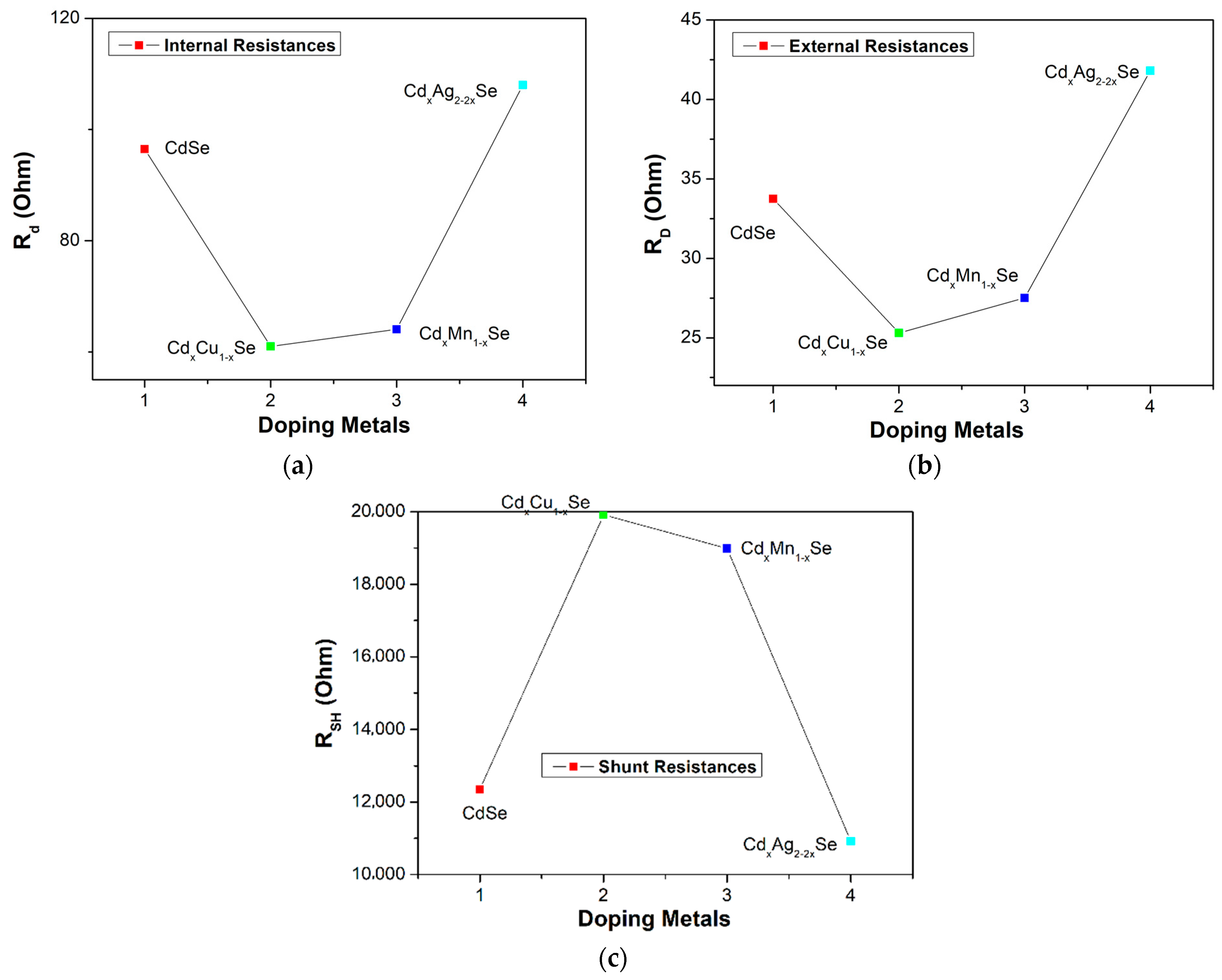

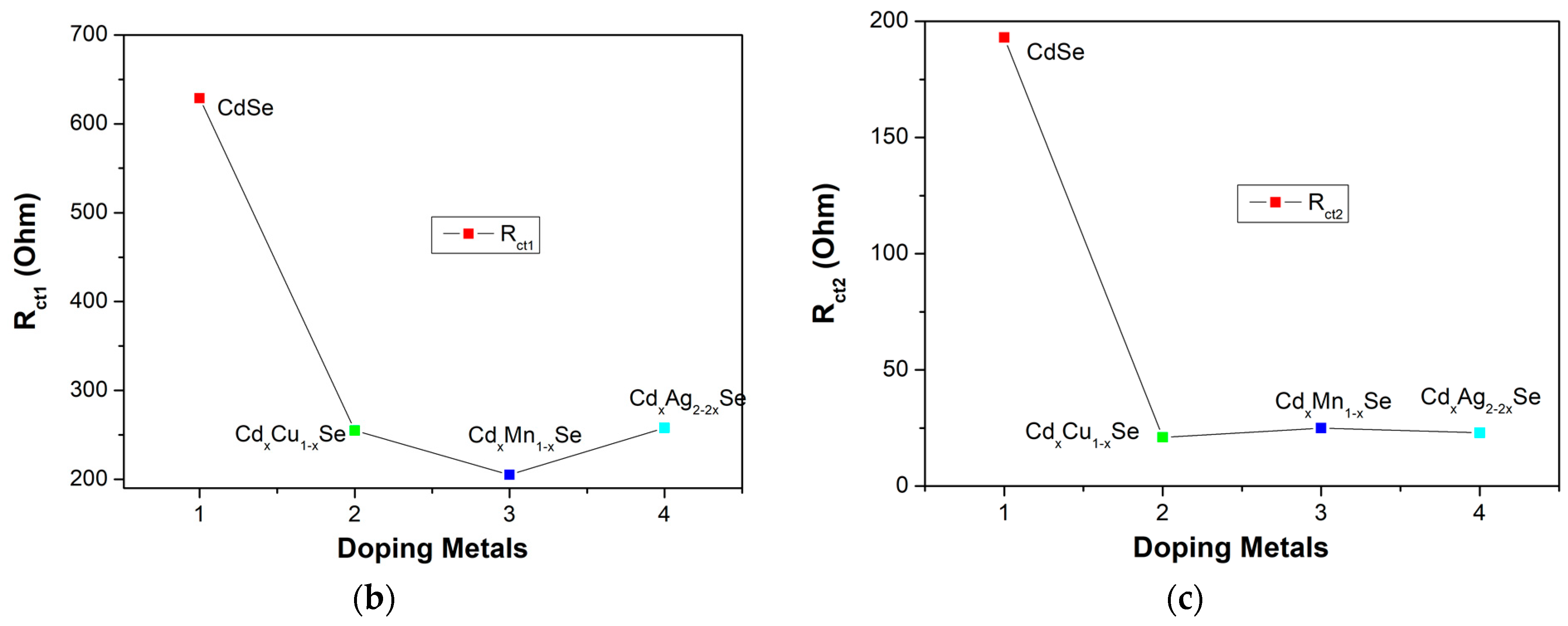
| Atom% | Eg (eV) | X (eV) | ECB (eV) | EVB (eV) | EU (eV) | σ (eV) | Ee-p (eV) |
|---|---|---|---|---|---|---|---|
| CdSe film | 2.08 | 5.145 | −4.105 | −6.2 | 0.786 | 0.033 | 20.25 |
| CdxCu1−xSe film | 1.87 | 4.91 | −3.98 | −5.85 | 2.11 | 0.012 | 54.5 |
| CdxMn1−xSe film | 1.79 | 4.62 | −3.7 | −5.5 | 2.33 | 0.011 | 59.97 |
| CdxAg2−2xSe film | 1.78 | 4.99 | −4.1 | −5.88 | 1.26 | 0.0205 | 32.6 |
| Atom% | JSC (mA/cm2) | FF | VOC (V) | η (%) | RD (Ω) | Rd (Ω) | RSH (kΩ) | RS (Ω) | Rct1 (Ω) | Rct2 (Ω) |
|---|---|---|---|---|---|---|---|---|---|---|
| CdSe film | 12.4 | 0.379 | 0.42 | 1.97 ± 0.01 | 33.75 | 96.5 | 12.4 | 62.8 | 629 | 193 |
| CdxCu1−xSe film | 19.89 | 0.419 | 0.505 | 4.24 ± 0.003 | 25.31 | 61 | 19.9 | 35.7 | 255 | 21 |
| CdxMn1−xSe film | 18.99 | 0.381 | 0.52 | 3.9 ± 0.005 | 27.51 | 64.1 | 18.99 | 36.6 | 205 | 25 |
| CdxAg2−2xSe film | 11 | 0.53 | 0.47 | 2.75 ± 0.008 | 41.81 | 108 | 10.92 | 66.2 | 256 | 23 |
Publisher’s Note: MDPI stays neutral with regard to jurisdictional claims in published maps and institutional affiliations. |
© 2021 by the authors. Licensee MDPI, Basel, Switzerland. This article is an open access article distributed under the terms and conditions of the Creative Commons Attribution (CC BY) license (https://creativecommons.org/licenses/by/4.0/).
Share and Cite
Huu Phuc, D.; Thanh Tung, H.; Nguyen, V.-C.; Hanh Nguyen Thi, M. The Influence of Dopant Concentration on Optical-Electrical Features of Quantum Dot-Sensitized Solar Cell. Molecules 2021, 26, 2865. https://doi.org/10.3390/molecules26102865
Huu Phuc D, Thanh Tung H, Nguyen V-C, Hanh Nguyen Thi M. The Influence of Dopant Concentration on Optical-Electrical Features of Quantum Dot-Sensitized Solar Cell. Molecules. 2021; 26(10):2865. https://doi.org/10.3390/molecules26102865
Chicago/Turabian StyleHuu Phuc, Dang, Ha Thanh Tung, Van-Cuong Nguyen, and My Hanh Nguyen Thi. 2021. "The Influence of Dopant Concentration on Optical-Electrical Features of Quantum Dot-Sensitized Solar Cell" Molecules 26, no. 10: 2865. https://doi.org/10.3390/molecules26102865






